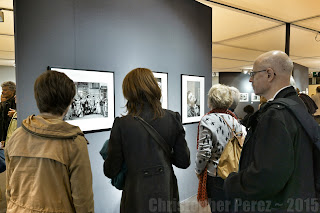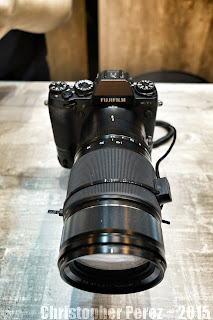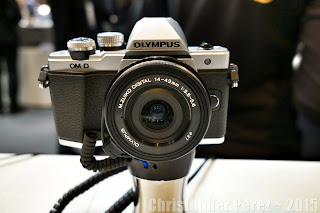In Part One of 2015 Salon de la Photo I ranted and raved and swung a bat over various camera and lens systems. I was in a very cranky mood.
Shocking as it may seem to some people, photography is more than selecting, collecting, and talking about equipment. As we all could/should know, the reason for all this gear is to be able to make images.
Fortunately, the Salon de la Photo was (barely?) more than just a trade show. This year there were a couple areas devoted to the works of well known artists.
Near the entrance to the show was an exhibition of mid to late 20th century images. All were printed in black and white to silver paper. The imaging themes were various. I could see that there was a certain aesthetic that I could clearly identify as being a Japanese view of the world. I felt that some of the images "worked" well and I enjoyed seeing them.
Toward the back of the building was a second show. This consisted of a small show of somewhat large, again, black and white silver-based prints. A quick look confirmed for me that the street photographer was American and I could see a classic New York point of view being expressed. I'm not sure I enjoyed what I saw. Perhaps it was too familiar.
Nearby were several booths devoted to the works of photographers who purchased space to hang, show, and sell their images. Browsing this area revealed to me a certain European aesthetic. The "look", regardless of the subject or theme, felt stark and somewhat remote. This was capped by a long wall filled with images of naked women holding strategically placed bloody organs and entrails of farm animals. I wondered why an artist would trade purely on shock value? Where would a person hang such images? On the living room wall?? Certainly not in my house.
Considering current imaging practice there were at least two areas in the middle of the show which caught my attention. They contained large prints of yet again black and white landscapes and portraits. The processing seemed to have made liberal use of Hipstamatic's Wetplate app. The effect wasn't bad, actually. I really enjoyed some of the portraits. But more than anything else I could see where cell phone image capture and processing has already taken over enormous areas of imaging responsibilities from traditional approaches.
And you would you like to know something? The large prints made from what were likely 8 mpixel cell phone cameras were very fine, indeed. Shocking, isn't it? But that's the truth. Apple and Google (Android) have done a phenomenal job at taking the place of traditional imaging tools manufacturers. Sure, Canon and Nikon will try to sell you on "flexibility" and "image quality". But so what? Very few of us ever shoot sporting events nor wildlife which might require long, big, expensive, large apertured optics. I could clearly see there is no need for such lavish tools when something so small, so light, and so readily available can do the task for Us Mere Mortals. I can easily see why Sony's QX series, Olympus' similar product, and DxO Mark's new device are starting to attract users.
I compared my visual experiences between the traditional and the current digital. The earlier silver-based black and white images have a certain "feel" to them. I feel in the highest expression of the art, prints can give a scene a "creamy" somewhat soft "look." Images like these elicit a "warm" feeling from me, regardless of the subject, content, or theme. Even many of St. Ansel's stark, cold, carefully controlled contrasty print style can have a certain "warmth."
Current digital print technique is far more flexible than the old silver-paper process. Digital can easily match black and white film-based imaging "warmth". It should be obvious there are a broad range of print papers and surface textures to choose from. Then there are the high definition book publishing (with image qualities indistinguishable from an "original" print) and network based distribution and sharing options. Each can way of sharing an image can lead a sensitive viewer in whatever direction the artist desires. All of which puts ever greater pressure on an artist.
Gone are the days when commercially available materials and tools narrowly defined the limits of what was possible. The Great Yellow Father (Kodak), Fuji Film, Agfa, and Ansco no longer set the limits of image capture and print making. Viewers are no longer constrained to poor reproduction quality books, nor are they required to visit a small number of galleries to see an original high quality print.
With an infinite variety of digital image processing outcomes, and a wide range of image print and networked distribution options, current practitioners of the photographic arts might feel a little overwhelmed. An artist needs a clear idea of what they want to accomplish, otherwise image making can quickly become a struggle and can be a "hit or miss" visual expression (that is, some images are "better" than others and the artist might not understand why).
Wandering the large show at Salon de la Photo, Paris left me with a better understanding of why so many "photographers" concentrate their time and energies on the tools and materials. It seems easier to talk about tools and materials capabilities as doing do sets boundaries and limits. A person can get lost talking about the minutia of this setting or that ISO or another lens. It probably feels "safe" to think materials and tools providers "will take care of them" by setting limits and boundaries that could induce a feeling of comfort, knowledge, and artistic competence.
I would like to consider the topic a little deeper in my own work. To feel a little more fulfilled as an artist I'd like to try to see the art and craft from other perspectives than from the point of view of a commercially driven trade show.
Given such vast imaging capabilities and possibilities, where might be the words that express what is creatively possible?
Even as it's too easy to place our faith in providers of tools and materials, how do we find a way to place faith in ourselves as artists?



















